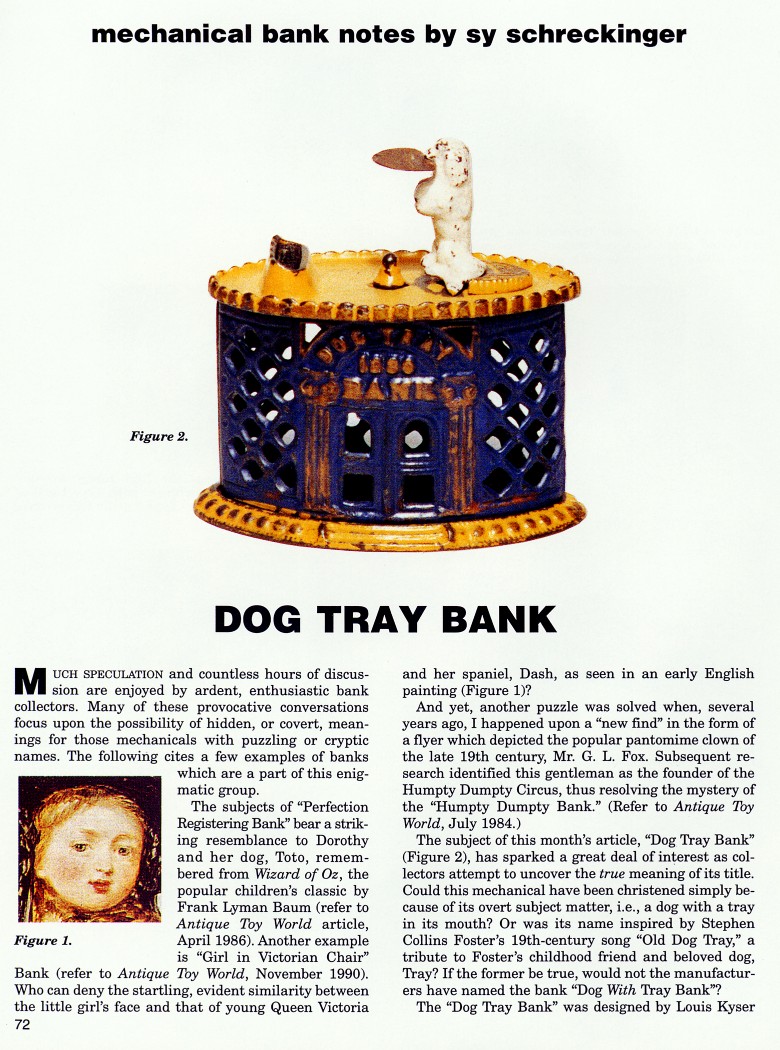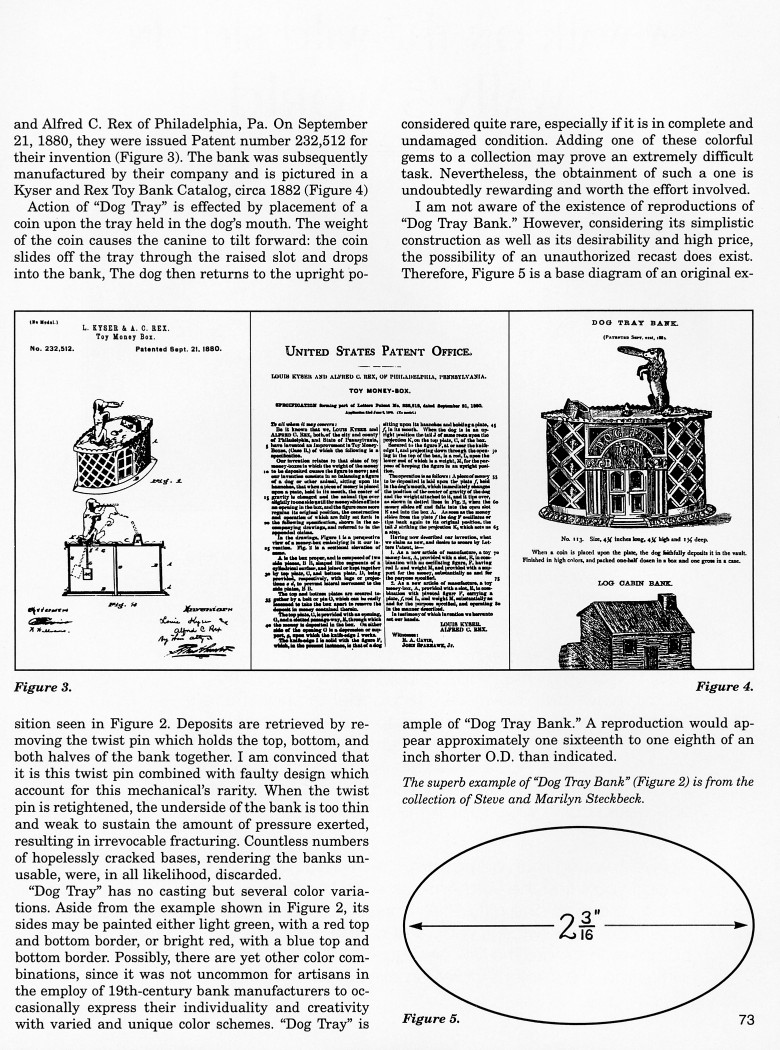|
Dog Tray Bank
by Sy Schreckinger – ANTIQUE TOY WORLD Magazine – December,
1997
Much speculation and countless hours of
discussion are enjoyed by ardent, enthusiastic bank collectors. Many of
these provocative conversations focus upon the possibility of hidden, or
covert, meanings for those mechanicals with puzzling or cryptic names. The
following cites a few examples of banks which are a part of this enigmatic
group.
The subjects of "Perfection Registering Bank" bear a striking
resemblance to Dorothy and her dog, Toto, remembered from Wizard of Oz,
the popular children's classic by Frank Lyman Baum (refer to Antique Toy
World article, April 1986). Another example is "Girl in Victorian Chair"
to Antique Toy World,
November 1990). Who can deny the startling, evident
similarity between the little girl's face and that of young Queen Victoria
and her spaniel, Dash, as seen in an early English painting (Figure 1)?
And yet, another puzzle was solved when, several years ago, I
happened upon a "new find" in the form of a flyer which depicted the
popular pantomime clown of the late 19th century, Mr. G. L. Fox.
Subsequent research identified this gentleman as the founder of the Humpty
Dumpty Circus, thus resolving the mystery of the "Humpty Dumpty Bank."
(Refer to Antique Toy World,
July 1984).
The subject of this month's article, "Dog Tray Bank" (Figure 2), has
sparked a great deal of interest as collectors attempt to uncover the true
meaning of its title. Could this mechanical have been christened simply
because of its overt subject matter, i.e., a dog with a tray in its mouth?
Or was its name inspired by Stephen Collins Foster's 19th-century song
"Old Dog Tray," a tribute to Foster's childhood friend and beloved dog,
Tray? If the former be true, would not the manufacturers have named the
bank "Dog With Tray Bank"?
The "Dog Tray Bank" was designed by Louis Kyser and Alfred C. Rex of
Philadelphia, Pa. On September 21, 1880, they were issued Patent number
232,512 for their invention (Figure 3). The bank was subsequently
manufactured by their company and is pictured in a Kyser and Rex Toy Bank
Catalog, circa 1882 (Figure 4).
Action of "Dog Tray" is effected by placement of a coin upon the tray held
in the dog's mouth. The weight of the coin causes the canine to tilt
forward: the coin slides off the tray through the raised slot and drops
into the bank, The dog then returns to the upright position seen in Figure
2. Deposits are retrieved by removing the twist pin which holds the top,
bottom, and both halves of the bank together. I am convinced that it is
this twist pin combined with faulty design which account for this
mechanical's rarity. When the twist pin is retightened, the underside of
the bank is too thin and weak to sustain the amount of pressure exerted,
resulting in irrevocable fracturing. Countless numbers of hopelessly
cracked bases, rendering the banks unusable, were, in all likelihood,
discarded.
"Dog Tray" has no casting but several color variations. Aside from
the example shown in Figure 2, its sides may be painted either light
green, with a red top and bottom border, or bright red, with a blue top
and bottom border. Possibly, there are yet other color combinations, since
it was not uncommon for artisans in the employ of 19th-century bank
manufacturers to occasionally express their individuality and creativity
with varied and unique color schemes. "Dog Tray" is considered quite rare, especially if it is in complete and undamaged
condition. Adding one of these colorful gems to a collection may prove an
extremely difficult task. Nevertheless, the obtainment of such a one is
undoubtedly rewarding and worth the effort involved.
I am not aware of the existence of reproductions of "Dog Tray Bank."
However, considering its simplistic construction as well as its
desirability and high price, the possibility of an unauthorized recast
does exist. Therefore, Figure 5 is a base diagram of an original example
of "Dog Tray Bank." A reproduction would appear approximately one
sixteenth to one eighth of an inch shorter O.D. than indicated.
The superb example of "Dog Tray Bank" (Figure 2) is from the
collection of Steve and Marilyn Steckbeck.
|


